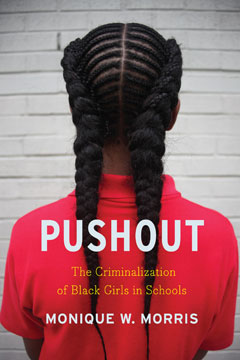
Monique W. Morris The New Press 2016 277 pages
“Though media and advocacy efforts have largely focused on the extreme and intolerable abuse cases involving Black boys,” begins Monique W. Morris in the introduction to her recently published book, “a growing number of cases involving Black girls have surfaced to reveal what many of us have known for centuries: Black girls are also directly impacted by criminalizing policies and practices that render them vulnerable to abuse, exploitation, dehumanization, and, under the worst circumstances, death.”
Morris looks at the lives of black girls who are faced with school-related arrest to discover the deeper stories beneath the surface. The results are shocking. There are girls who are abused; trafficked for sex; harassed because of race, gender, sexual orientation or a combination of all three; and/or otherwise violated. And yet, somehow, Morris writes, in their progress through the juvenile justice system, these crimes against girls have not come to light.
Instead, the girls are pushed out of the school system and into a cycle of prison, unemployment and homelessness due to a lack of interest by the systems and authority figures that have failed them. “One of the most persistent and salient traits among girls who have been labeled ‘delinquent’ is that they have failed to establish a meaningful and sustainable connection with schools,’” continues Morris, before adding that “nearly 48 percent of Black girls who are expelled nationwide do not have access to educational services.”
In writing “Pushout,” Monique Morris devoted four years of investigative reporting to portray the lives of black girls across America. Grounded in compelling narratives, this is a deeply researched and thorough accounting of the lives of black girls in America. “Black girls are 16 percent of the female student population, but nearly one-third of all female school-based arrests,” Morris writes.
She offers numerous, detailed accounts of these arrests, mostly disproportionate to the level of infraction and age of the student. For example: “In May 2013, Ashlynn Avery, a sixteen-year-old diabetic girl in Alabama, fell asleep while reading Huckleberry Finn during her in-school suspension” and “the suspension supervisor allegedly threw a book at her” before “a police officer allegedly slammed her face into a file cabinet and then arrested her.” Another incident Morris recounts occurred in 2013 when “sixteen-year-old Kiera Wilmot was charged with a felony offense when what she said was a science experiment went wrong, leaving her subjected to a mandatory suspension and arrest following an unauthorized ‘explosion’ on school grounds.”
Morris also recounts what happened to Jmiya Rickman, one of many black girls in kindergarten who have been arrested by police. “In 2013, eight-year-old Jmiya Rickman, an autistic child who also suffered from depression and separation anxiety, had her hands, feet and waist put in cuffs, and was arrested in her Illinois elementary school after throwing a ‘bad tantrum.’”
The girls’ stories are horrifying — but not unique. Over and over, Morris found, black girls across the country recounted stories of being on the receiving end of excessive, traumatic violence in the school environment. Morris grounds these narratives in the historical context of racial violence in America, harkening back to slavery and the Jim Crow era to connect the dots between the devaluation and dehumanization of black girls then and now. One poignant example is the account of the terror Carolyn Smith articulated in an 1871 testimony before Congress, describing violence from the Ku Klux Klan in her endeavor to obtain an education that included threats, beatings and book-burning.
In later chapters, Morris deconstructs the stereotype of heightened “Jezebel” sexuality projected onto black girls in the classroom and the accompanying sexualized violence enacted upon their bodies. Most heartbreaking is the lack of help from school officials when black girls came to them for protection from assault. Quite often, the girls were suspended equally with the boys who committed the assault. At times, there was direct violence from the teachers themselves.
But there is hope: Morris concludes her book by offering suggestions for “repairing relationships and rebuilding connections” between black girls and the educational system that is supposed to serve them — and offers several useful appendices with additional reading and a helpful question-and-answer section to begin the work.
Deeply compelling and vividly written, “Pushout” is necessary reading for youth workers of all kinds: counselors, teachers, principals, after-school program leaders, administrators and school safety officers.
“Pushout” clearly lays out ways in which racial bias unfairly targets black girls, causing them to be singled out for greater and more severe punishment than their nonblack peers. The book brings awareness of internalized racial bias to foster a climate and set of policies that deals more fairly with black girls and to plan ways to reach out to this population to help them be safe and thrive.
Further Reading:
“Black Women in White America,” by Gerda Lerner, published by Vintage Books, 1992, 672 pages.
A reissue of the groundbreaking and original 1972 compilation of letters, articles and essays on the black female experience in white society by the renowned historian.
“The Sisters Are Alright: Changing the Broken Narrative of Black Women in America,” by Tami Winfrey Harris, published by Berrett-Koehler, 2015, 160 pages.
An insightful and inspirational exploration of the many diverse ways black women triumph over negative stereotypes, racial and gender discrimination and succeed.
“Women’s Ways of Knowing: The Development of Self, Voice and Mind,” by Mary Field Belenky, Blythe McVicker Clinchy, and Nancy Rule Goldberg, published by Basic Books, 1997.
A compilation of 135 interviews with everyday women, exploring the ways women learn, express themselves and move through social spaces and relationships.
Pingback: Hacia el aprendizaje colectivo | SchoolRubric
Pingback: Towards Colearning | SchoolRubric